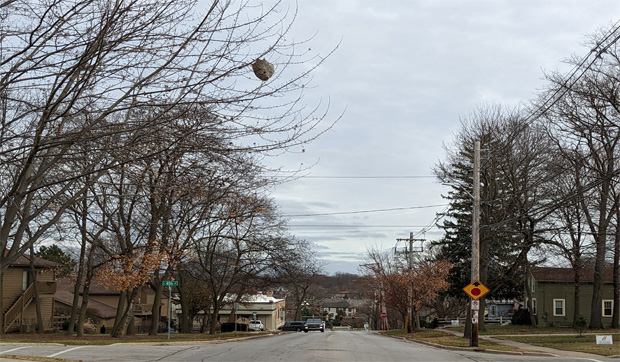Bald-faced hornet nests, like this large one in St. Charles, are revealed when the leaves fall from the tree. The former residents, a type of paper wasps, are gone and will not return. But their frozen remains can provide valuable protein to winter wildlife when the nests remain in place.
Good Natured: Bald-faced Hornet Nests
January 27, 2023
The old home sat at the corner of Fourth and Prairie Streets, a few blocks south of downtown St. Charles.
In its heyday it buzzed with busy-ness. An absolute hive of activity, its hardworking residents came and went throughout the day. In some ways, their daily tasks were much like ours: feed the kids; feed themselves; keep the homestead in good repair; keep intruders out. Oh, and make sure the queen has everything she needs.
You’ve probably figured out by now, we’re not talking about a sprawling brick foursquare or a grand Victorian (although I suppose it could be a Queen Anne, if the resident queen was so named). Nope, the topic of this week’s dispatch is a home created by none other than Dolichovespula maculata, the bald-faced hornet, a type of paper wasp.
By the time anyone noticed this particular nest late last year, the leaves on the maple in which it was built had fallen and dispersed. Thus exposed, the impressive structure hung over Prairie Street like an exquisite ornament awaiting the coming holiday season.
When a local resident told me about the nest, I couldn’t wait to scurry over and see it. Most structures of this type, built a few millimeters at a time by first dozens and then hundreds of worker wasps, top out around the size of a football or volleyball. But this one, the source assured, was at least the size of a basketball, and maybe even a beach ball. Hot diggity!
Let me tell you, it did not disappoint. Even better, its great size promised lots more interesting observations to come. For inside its gray-brown exterior (a wondrous feature in itself, consisting of multiple layers of wasp-manufactured paper) lie the frozen remains of the residents-dozens and dozens of adult wasps as well as larvae. Or, in other words, lots and lots of protein, free for the taking!
I couldn’t wait to see what wildlife would avail themselves of the bounteous buffet within those paper walls. In past winters, I’ve watched other nests get torn open by chickadees, woodpeckers and squirrels helping themselves to the meaty morsels. Which species would be the first to dig into this Prairie Street feast?
Exactly eight days later, on December 21, I decided to walk back over to see if Chateau de Wasp was still intact. Visions of redbellies-woodpeckers, that is-danced in my head I made my way up Fourth to Prairie. But what to my wondering eyes should appear, but…bare branches! The nest-the lovely, glorious, beautiful nest-was gone!
My mood plummeted as I snapped a quick photo and walked slowly away. Where could it have gone? We’d had some stiff breezes recently, but no strong winds. And the nest was way too high to have been knocked down by a passing vehicle-even a really tall one.
During the rest of my walk that day I consoled myself by envisioning various circumstances that could have led to the nest’s demise. Maybe a raccoon inched its way out to the edge of the branch and knocked the whole kit and kaboodle down. Maybe, I thought hopefully, there will be nest scraps on the ground nearby.
Alas, no such luck.
I continued to mull over other scenarios on and off throughout the day, but couldn’t come up with anything plausible. Walking past the tree on my way home that night I arrived at the conclusion that, well, sometimes these things just happen. But then things got weirder.
Approaching my house, I looked up at parkway tree I share with my neighbor to the south. A wasp colony had resided there too, though I wasn’t aware of it until the leaves came down. But where the nest had been was nothing but…bare branches. That nest was gone too!
Slowly my brain began to connect the dots… Two nests missing from two trees in two public right-of-ways. Hmmm. Could these nest removals be related?
It turns out, they were. Our city’s Forestry department, a hardworking crew that aims to please, would remove wasp nests from parkway trees at residents’ requests.
Ruh roh, I thought to myself. This is a practice that needs some modification. And as a member of St. Charles’ Natural Resources Commission, I had an idea of how to do it. Several years ago we’d put together some information on native tree species, to help educate residents on the diversity of trees available beyond maples, which was the genus of choice whenever a parkway tree needed replacing. It worked, and our urban forest is more diverse because of it. Could something similar work with wasp nests?
I wasn’t going to be able to attend the January meeting, but with the help of my friend and fellow commissioner Suzi Myers we were able to tell the story of bald-faced hornets nests, how the wasps do not return in spring, and how helpful the frozen wasps inside can be to winter wildlife.
I’m happy to report, the other NRC commissioners agreed! Now when local residents call with concerns about wasp nests in parkway trees, they’ll be able to learn more about the role of these structures in our suburban ecosystem. More information also will be posted in February in The Den, the City’s monthly newsletter, https://www.stcharlesil.gov/news/den Check it out!
Pam Otto is the outreach ambassador for the St. Charles Park District. She can be reached at potto@stcparks.org.

